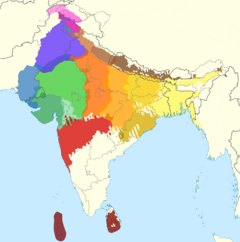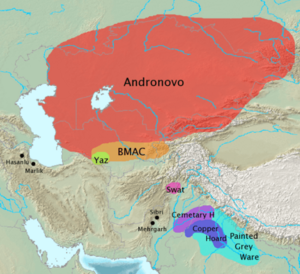Indo-Aryan peoples facts for kids

1978 map showing geographical distribution of the major Indo-Aryan languages. (Urdu is included under Hindi. Romani, Domari, and Lomavren are outside the scope of the map.) Dotted/striped areas indicate where multilingualism is common.
|
|
| Total population | |
|---|---|
| ~1.5 billion | |
| Regions with significant populations | |
| over 911 million | |
| over 190 million | |
| over 160 million | |
| over 26 million | |
| over 14 million | |
| over 2 million | |
| over 725,400 | |
| over 300,000 | |
| over 240,000 | |
| Languages | |
| Indo-Aryan languages | |
| Religion | |
| Indian religions (Mostly Hindu; with Buddhist, Sikh and Jain minorities) and Islam, Christians and some non-religious atheist/agnostic | |
Indo-Aryan peoples are a diverse collection of peoples speaking Indo-Aryan languages in the Indian subcontinent. Historically, Aryans were the Indo-Iranian speaking pastoralists who migrated from Central Asia into South Asia and introduced the Proto-Indo-Aryan language. The early Indo-Aryan peoples were known to be closely related and belonging to the same Indo-Iranian group that have resided north of the Indus River; an evident connection in cultural, linguistic, and historical ties. Today, Indo-Aryan speakers are found south of the Indus, across the modern-day regions of Bangladesh, Nepal, eastern-Pakistan, Sri Lanka, Maldives and northern-India.
Contents
History
Proto-Indo-Iranians

The introduction of the Indo-Aryan languages in the Indian subcontinent was the result of a migration of Indo-Aryan people from Central Asia into the northern Indian subcontinent (modern-day Bangladesh, Bhutan, India, Nepal, Pakistan, and Sri Lanka). These migrations started approximately 1,800 BCE, after the invention of the war chariot, and also brought Indo-Aryan languages into the Levant and possibly Inner Asia. Another group of Indo-Aryans migrated further westward and founded the Mitanni kingdom in northern Syria; (c. 1500–1300 BC) the other group was the Vedic people. Christopher I. Beckwith suggests that the Wusun, an Indo-European Caucasoid people of Inner Asia in antiquity, were also of Indo-Aryan origin.
The Proto-Indo-Iranians, from which the Indo-Aryans developed, are identified with the Sintashta culture (2100–1800 BCE), and the Andronovo culture, which flourished ca. 1800–1400 BCE in the steppes around the Aral Sea, present-day Kazakhstan, Turkmenistan, and Uzbekistan. The Proto-Indo-Aryan split off around 1800–1600 BCE from the Iranians, moved south through the Bactria-Margiana Culture, south of the Andronovo culture, borrowing some of their distinctive religious beliefs and practices from the BMAC, and then migrated further south into the Levant and north-western India. The migration of the Indo-Aryans was part of the larger diffusion of Indo-European languages from the Proto-Indo-European homeland at the Pontic–Caspian steppe which started in the 4th millennium BCE. The GGC, Cemetery H, Copper Hoard, OCP, and PGW cultures are candidates for cultures associated with Indo-Aryans.
The Indo-Aryans were united by shared cultural norms and language, referred to as aryā 'noble'. Over the last four millennia, the Indo-Aryan culture has evolved particularly inside India itself, but its origins are in the conflation of values and heritage of the Indo-Aryan and indigenous people groups of India. Diffusion of this culture and language took place by patron-client systems, which allowed for the absorption and acculturation of other groups into this culture, and explains the strong influence on other cultures with which it interacted.
Genetically, most Indo-Aryan-speaking populations are descendants of a mix of Central Asian steppe pastoralists, Iranian hunter-gatherers, and, to a lesser extent, South Asian hunter-gatherers—commonly known as Ancient Ancestral South Indians (AASI). Dravidians are descendants of a mix of South Asian hunter-gatherers and Iranian hunter-gatherers, and to a lesser extent, Central Asian steppe pastoralists. South Indian Tribal Dravidians descend majorly from South Asian hunter-gatherers, and to a lesser extent Iranian hunter-gatherers. Additionally, Austroasiatic and Tibeto-Burmese speaking people contributed to the genetic make-up of South Asia.
Indigenous Aryanism propagates the idea that the Indo-Aryans were indigenous to the Indian subcontinent, and that the Indo-European languages spread from there to central Asia and Europe. Contemporary support for this idea is ideologically driven, and has no basis in objective data and mainstream scholarship.
List of historical Indo-Aryan peoples
- Anga
- Bahlikas
- Bharatas
- Caidyas
- Dewa
- Gāndhārīs
- Gangaridai
- Gurjara-Pratihara
- Gupta
- Kambojas
- Kalinga
- Kasmira
- Kekaya
- Khasas
- Kikata
- Koliya
- Kosala
- Kurus
- Licchavis
- Madra
- Magadhis
- Malavas
- Mallakas
- Mātsyeyas
- Moriya
- Nishadhas
- Odra
- Pakthas
- Pala
- Panchala
- Paundra
- Puru
- Salva
- Salwa
- Saraswata
- Sauvira
- Shakya
- Shunga
- Sindhu
- Sudra
- Surasena
- Trigarta
- Utkala
- Vanga
- Vatsa
- Vidarbha
- Videha
- Yadava
- Yadu
Contemporary Indo-Aryan people
- Assamese people
- Awadhi people
- Banjara people
- Bengali people
- Bhil people
- Bhojpuri people
- Bishnupriya Manipuri people
- Brokpa people
- Chakma people
- Deccani people
- Dhivehi people
- Dogra people
- Garhwali people
- Gujarati people
- Halba people
- Haryanvi people
- Jaunsari people
- Kalash people
- Kashmiri people
- Khas people
- Kho people
- Kohistani people
- Konkani people
- Kumauni people
- Kutchi people
- Magahi people
- Muhajir people
- Maithil people
- Marathi people
- Marwari people
- Nagpuria people
- Odia people
- Palula people
- Pashayi people
- Pahari people
- Punjabi people
- Rajasthani people
- Romani people
- Rohingya people
- Sadan people
- Saraiki people
- Saurashtra people
- Shina people
- Sindhi people
- Sinhalese people
- Thari people
- Tharu people
- Thori people
- Tirahi people
- Torwali people
- Warli people
See also
- Proto-Indo-Europeans
- Indo-Iranians
- Dardic peoples
- Aryan
- Indo-Aryan languages
- Indo-Aryan migrations
- Indigenous Aryanism
- Aryan race
- Aryavarta
- Dasa
- Dravidian peoples
- Early Indians
- South Asian diaspora
- Northern South Asia

